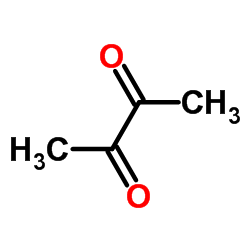butane-2,3-dione

butane-2,3-dione structure
|
Common Name | butane-2,3-dione | ||
|---|---|---|---|---|
| CAS Number | 431-03-8 | Molecular Weight | 86.089 | |
| Density | 1.0±0.1 g/cm3 | Boiling Point | 88.0±0.0 °C at 760 mmHg | |
| Molecular Formula | C4H6O2 | Melting Point | -4--2 °C | |
| MSDS | Chinese USA | Flash Point | 7.2±0.0 °C | |
| Symbol |



GHS02, GHS05, GHS06 |
Signal Word | Danger | |
|
Olfactometry Profiles and Quantitation of Volatile Sulfur Compounds of Swiss Tilsit Cheeses.
J. Agric. Food Chem. 63 , 7511-21, (2015) To establish the odor profiles of three differently fabricated commercial Swiss Tilsit cheeses, analyses were conducted using headspace solid-phase microextraction gas chromatography-mass spectrometry/pulsed flame photometric detection and gas chromatography-... |
|
|
Chemical genetics reveals a complex functional ground state of neural stem cells.
Nat. Chem. Biol. 3(5) , 268-273, (2007) The identification of self-renewing and multipotent neural stem cells (NSCs) in the mammalian brain holds promise for the treatment of neurological diseases and has yielded new insight into brain cancer. However, the complete repertoire of signaling pathways ... |
|
|
A joint analysis of metabolomics and genetics of breast cancer.
Breast Cancer Res. 16(4) , 415, (2014) Remodeling of cellular metabolism appears to be a consequence and possibly a cause of oncogenic transformation in human cancers. Specific aspects of altered tumor metabolism may be amenable to therapeutic intervention and could be coordinated with other targe... |
|
|
Method development by GC-ECD and HS-SPME-GC-MS for beer volatile analysis.
Food Chem. 167 , 71-7, (2014) Two methods for the extraction, identification and quantification of the highest occurrence and lowest perception threshold off-flavours in fifteen different samples of Brazilian Pilsner beers were developed. For this purpose, headspace solid phase microextra... |
|
|
Butane-2,3-dione: the key contributor to axillary and foot odor associated with an acidic note.
Chem. Biodivers. 12(2) , 248-58, (2015) Human body odor, which contains several volatile organic compounds, possesses various odor qualities. To identify key volatile compounds responsible for the common unpleasant odors derived from human axillae and feet, the odor quality and intensity of 118 hum... |
|
|
Identification and characterization of novel benzil (diphenylethane-1,2-dione) analogues as inhibitors of mammalian carboxylesterases.
J. Med. Chem. 48 , 2906-15, (2005) Carboxylesterases (CE) are ubiquitous enzymes responsible for the metabolism of xenobiotics. Because the structural and amino acid homology among esterases of different classes, the identification of selective inhibitors of these proteins has proved problemat... |
|
|
Studies on the Formation of Maillard and Caramelization Products from Glucosamine Incubated at 37 °C.
J. Agric. Food Chem. 63 , 6249-61, (2015) This experiment compared the in vitro degradation of glucosamine (GlcN), N-acetylglucosamine, and glucose in the presence of NH3 incubated at 37 °C in phosphate buffer from 0.5 to 12 days. The reactions were monitored with UV-vis absorption and fluorescence e... |
|
|
Substance P induces cardioprotection in ischemia-reperfusion via activation of AKT.
Am. J. Physiol. Heart Circ. Physiol. 309 , H676-84, (2015) Accumulating evidence indicates that substance P is cardioprotective following ischemia-reperfusion primarily due to its potent coronary vasodilator actions. However, an anti-apoptotic effect of substance P has been observed in tenocytes following ischemia, w... |
|
|
Characterization of Volatile Flavor Compounds in Chinese Rice Wine Fermented from Enzymatic Extruded Rice.
J. Food Sci. 80 , C1476-89, (2015) Enzymatic extrusion, instead of traditional steam cooking, to treat rice is an efficient and alternative pretreatment for Chinese rice wine fermentation. In order to determine the formation of volatiles in enzymatic extrusion-processed rice wine (EE), and to ... |
|
|
Functional interaction between bicarbonate transporters and carbonic anhydrase modulates lactate uptake into mouse cardiomyocytes.
Pflugers Arch. 467 , 1469-80, (2015) Blood-derived lactate is a precious energy substrate for the heart muscle. Lactate is transported into cardiomyocytes via monocarboxylate transporters (MCTs) together with H(+), which couples lactate uptake to cellular pH regulation. In this study, we have in... |